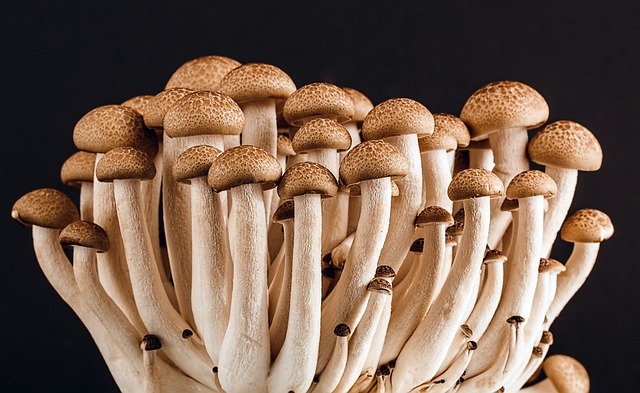1. Which of the following is a characteristic feature of fungi?
(a) They are autotrophic
(b) They lack chlorophyll
(c) They are unicellular
(d) They are prokaryotic
2. The cell wall of fungi is mainly composed of:
(a) Cellulose
(b) Chitin
(c) Pectin
(d) Lignin
3. Which of the following is a true fungal disease in humans?
(a) Malaria
(b) Tuberculosis
(c) Ringworm
(d) Typhoid
.
4. Yeasts are examples of:
(a) Multicellular fungi
(b) Unicellular fungi
(c) Symbiotic fungi
(d) Saprophytic fungi
5. Fungi are classified under which of the following kingdoms?
(a) Plantae
(b) Animalia
(c) Fungi
(d) Protista
Most Important Mcqs on Kingdom Fungi
6. Which type of reproduction is found in Rhizopus?
(a) Binary fission
(b) Budding
(c) Fragmentation
(d) Spore formation
7. Which of the following is a characteristic of chytrids?
(a) They have a distinct sexual reproductive phase
(b) They are unicellular
(c) They are non-motile
(d) They have flagellated spores
8. Lichens are the result of a symbiotic relationship between:
(a) Fungi and algae
(b) Fungi and bacteria
(c) Algae and bacteria
(d) Plants and fungi
- Which of the following is a fungal disease caused by the fungus Aspergillus?
(a) Candidiasis
(b) Aspergillosis
(c) Athlete’s foot
(d) Histoplasmosis
10. Which of the following is a fungal disease caused by the fungus Aspergillus?
(a) Candidiasis
(b) Aspergillosis
(c) Athlete’s foot
(d) Histoplasmosis
11. The process of sexual reproduction in fungi involves the formation of:
(a) Conidia
(b) Basidiospores
(c) Zygospores
(d) Both b and c
12. The mycelium of a fungus is made up of:
(a) Hyphae
(b) Sporangia
(c) Conidia
(d) Spores
13. Fungi that obtain nutrients from dead and decaying matter are:
(a) Symbiotic
(b) Saprophytic
(c) Parasitic
(d) Photosynthetic
14. The reproductive structure of yeast is:
(a) Conidium
(b) Ascus
(c) Sporangium
(d) Bud
15. The typical fruiting body of Ascomycota is called:
(a) Basidiocarp
(b) Ascoma
(c) Sporocarp
(d) Zygosporangium
16. Which of the following is an example of an edible fungus?
(a) Mucor
(b) Agaricus
(c) Aspergillus
(d) Claviceps
17. What is the function of rhizoids in fungi?
(a) Reproduction
(b) Nutrient absorption
(c) Protection
(d) Spore formation
18. The sexual reproduction in basidiomycetes occurs through:
(a) Zygospores
(b) Conidia
(c) Basidiospores
(d) Ascospore
19. Which of the following fungi is used in the production of antibiotics?
(a) Aspergillus
(b) Penicillium
(c) Mucor
(d) Rhizopus
20. In which of the following classes of fungi does sexual reproduction involve the formation of zygospores?
(a) Ascomycota
(b) Basidiomycota
(c) Zygomycota
(d) Deuteromycota
21. The symbiotic relationship in lichens is between:
(a) Algae and bacteria
(b) Fungi and plants
(c) Fungi and algae or cyanobacteria
(d) Fungi and animals
22. The conidia of Penicillium are produced by:
(a) Sexual reproduction
(b) Budding
(c) Asexual reproduction
(d) Fragmentation
23. What type of fungus is responsible for causing ergot disease in rye?
(a) Claviceps
(b) Penicillium
(c) Aspergillus
(d) Rhizopus
24. The most common method of asexual reproduction in fungi is:
(a) Binary fission
(b) Spore formation
(c) Budding
(d) Fragmentation
25. The sac-like structure in Ascomycetes that contains ascospores is called:
(a) Basidium
(b) Ascus
(c) Sporangium
(d) Zygosporangium
26. Which of the following fungi cause the disease known as athlete’s foot?
(a) Candida
(b) Aspergillus
(c) Trichophyton
(d) Mucor
27. Which of the following is a pathogenic fungus that infects plants?
(a) Saccharomyces
(b) Fusarium
(c) Mucor
(d) Aspergillus
28. Fungi that can grow on bread are usually:
(a) Basidiomycetes
(b) Ascomycetes
(c) Zygomycetes
(d) Deuteromycetes
29. Which of the following is not a type of fungal spore?
(a) Conidium
(b) Zygospore
(c) Ascospores
(d) Phytospore
30. The primary function of hyphae in fungi is:
(a) Absorption of water
(b) Absorption of nutrients
(c) Reproduction
(d) Photosynthesis
31. Which of the following is a characteristic of Deuteromycota?
(a) They lack sexual reproduction
(b) They have asexual reproduction only
(c) They produce zygospores
(d) They have flagellated spores
32. Which of the following fungi is used in baking?
(a) Saccharomyces cerevisiae
(b) Penicillium notatum
(c) Aspergillus niger
(d) Mucor mucedo
33. What is the function of the fruiting body in fungi?
(a) Photosynthesis
(b) Nutrient absorption
(c) Sexual reproduction
(d) Asexual reproduction
34. The hyphal structure in fungi that forms the mat-like network is called:
(a) Mycelium
(b) Sporangiophore
(c) Hyphophore
(d) Fructification
35. Which of the following is true about fungal spores?
(a) They are non-motile
(b) They are reproductive bodies
(c) They are always formed sexually
(d) They are part of the fungal mycelium
36. What is the primary role of fungi in the ecosystem?
(a) Producers
(b) Decomposers
(c) Herbivores
(d) Carnivores
37. The fungi that can infect humans and cause a disease known as candidiasis are:
(a) Aspergillus
(b) Candida
(c) Trichophyton
(d) Penicillium
38. What is the source of penicillin?
(a) Penicillium chrysogenum
(b) Aspergillus flavus
(c) Fusarium oxysporum
(d) Mucor mucedo
39. In which class of fungi do the sporangia develop on a specialised stalk?
(a) Ascomycota
(b) Basidiomycota
(c) Zygomycota
(d) Deuteromycota
40. The structures that form the mycelium of fungi are:
(a) Hyphae
(b) Conidia
(c) Asci
(d) Sporangia
41. Asexual reproduction in fungi often occurs through the formation of:
(a) Zygospores
(b) Conidia
(c) Basidiospores
(d) Ascospores
42. Fungi that obtain their nutrition from living hosts are called:
(a) Saprophytes
(b) Parasites
(c) Symbionts
(d) Autotrophs
43. What is the type of sexual reproduction in Basidiomycota?
(a) Conidial formation
(b) Zygospore formation
(c) Basidiospore formation
(d) Ascus formation
44. The spore-producing body in Basidiomycetes is called:
(a) Ascus
(b) Conidium
(c) Basidiocarp
(d) Zygosporangium
45. What is the main characteristic of the class Deuteromycota?
(a) They do not produce sexual spores
(b) They reproduce only through fragmentation
(c) They only produce zygospores
(d) They do not have any mycelium
46. The fungus used to ferment alcoholic beverages is:
(a) Saccharomyces cerevisiae
(b) Aspergillus niger
(c) Rhizopus stolonifer
(d) Penicillium notatum
47. Which of the following fungal species is used in the production of citric acid?
(a) Rhizopus stolonifer
(b) Aspergillus niger
(c) Penicillium roqueforti
(d) Saccharomyces cerevisiae
48. Which of the following fungi form fruiting bodies that resemble mushrooms?
(a) Zygomycetes
(b) Ascomycetes
(c) Basidiomycetes
(d) Deuteromycetes
49. The sexual reproduction of fungi produces:
(a) Sporangia
(b) Conidia
(c) Zygospores or Ascospores
(d) Mycelium
50. The fungal structure responsible for nutrient absorption is:
(a) Mycelium
(b) Conidia
(c) Hyphae
(d) Sporangium
Answer with Explanations
- Answer: (b) They lack chlorophyll
Explanation: Fungi are heterotrophic organisms and lack chlorophyll, unlike plants, which are autotrophic.
- Answer: (b) Chitin
Explanation: The cell wall of fungi is primarily made up of chitin, which provides structural support.
- Answer: (c) Ringworm
Explanation: Ringworm is a fungal infection of the skin caused by dermatophytes
4. Answer: (b) Unicellular fungi
Explanation: Yeasts are unicellular fungi that reproduce through budding.
- Answer: (c) Fungi
Explanation: Fungi belong to the kingdom Fungi, which is distinct from Plantae and Animalia.
- Answer: (d) Spore formation
Explanation: Rhizopus (a type of bread mold) reproduces through spore formation (both asexual and sexual spores).
7. Answer: (d) They have flagellated spores
Explanation: Chytrids are unique among fungi because they produce flagellated spores, which are motile.
- Answer: (a) Fungi and algae
Explanation: Lichens are formed by a mutualistic relationship between fungi and photosynthetic organisms like algae.
- Answer: (b) Aspergillosis
Explanation: Aspergillosis is an infection caused by the fungus Aspergillus, commonly affecting the lungs.
- Answer: (c) Have chlorophyll
Explanation: Fungi are heterotrophic and lack chlorophyll.
11 Answer: (d) Both b and c
Explanation: Fungi reproduce sexually through the formation of basidiospores (in Basidiomycota) or zygospores (in Zygomycota).
- Answer: (a) Hyphae
Explanation: The mycelium is the mass of thread-like structures called hyphae that form the vegetative part of a fungus.
- Answer: (b) Saprophytic
Explanation: Saprophytic fungi decompose and absorb nutrients from dead organic matter.
- Answer: (d) Bud
Explanation: Yeasts reproduce asexually by budding, where a new cell forms from a protrusion of the parent cell.
- Answer: (b) Ascoma
Explanation: Ascomycota, also known as sac fungi, have a fruiting body called the ascoma, which contains asci where sexual spores are formed.
- Answer: (b) Agaricus
Explanation: Agaricus is the genus that includes the common edible mushroom, Agaricus bisporus
- Answer: (b) Nutrient absorption
Explanation: Rhizoids are thread-like structures that anchor the fungus to a surface and absorb nutrients.
- Answer: (c) Basidiospores
Explanation: Basidiomycetes reproduce sexually through the production of basidiospores in the basidium.
- Answer: (b) Penicillium
Explanation: Penicillium species are used in the production of the antibiotic penicillin.
- Answer: (c) Zygomycota
Explanation: Zygomycota reproduce sexually through the formation of zygospores.
- Answer: (c) Fungi and algae or cyanobacteria
Explanation: Lichens are a mutualistic symbiosis between fungi and photosynthetic organisms like algae or cyanobacteria.
- Answer: (c) Asexual reproduction
Explanation: Penicillium produces conidia (asexual spores) for reproduction.
- Answer: (a) Claviceps
Explanation: Claviceps purpurea causes ergot disease in rye, which produces toxic alkaloids.
- Answer: (b) Spore formation
Explanation: Most fungi reproduce asexually by producing spores that germinate into new individuals.
- Answer: (b) Ascus
Explanation: The ascus is a sac-like structure that contains the ascospores in Ascomycetes.
- Answer: (c) Trichophyton
Explanation: Trichophyton is a genus of fungi responsible for causing athlete’s foot (tinea pedis), a common skin infection.
- Answer: (b) Fusarium
Explanation: Fusarium is a genus of fungi that causes several plant diseases, including wilt and rot.
- Answer: (c) Zygomycetes
Explanation: Zygomycetes like Rhizopus are commonly found growing on bread, especially when it becomes moist.
- Answer: (d) Phytospore
Explanation: Phytospore is not a type of fungal spore. The other three are types of fungal spores.
- Answer: (b) Absorption of nutrients
Explanation: The primary role of hyphae is to absorb nutrients from the environment.
- Answer: (a) They lack sexual reproduction
Explanation: Deuteromycota, also known as “imperfect fungi,” do not exhibit sexual.
- Answer: (a) Saccharomyces cerevisiae
Explanation: Saccharomyces cerevisiae is the yeast used in baking for fermentation.
- Answer: (c) Sexual reproduction
Explanation: The fruiting body of fungi produces and releases spores, which is part of the sexual reproduction process.
- Answer: (a) Mycelium
Explanation: Mycelium is the dense mat of hyphae that makes up the vegetative structure of a fungus.
- Answer: (b) They are reproductive bodies
Explanation: Fungal spores serve as the primary means of reproduction and dispersal.
- Answer: (b) Decomposers
Explanation: Fungi play a critical role as decomposers, breaking down dead organic matter and recycling nutrients.
- Answer: (b) Candida
Explanation: Candida is a genus of yeast that causes infections like thrush and vaginal yeast infections.
- Answer: (a) Penicillium chrysogenum
Explanation: The antibiotic penicillin is derived from Penicillium chrysogenum.
- Answer: (c) Zygomycota
Explanation: In Zygomycota, sporangia develop on specialized stalks called sporangiophores
- Answer: (a) Hyphae
Explanation: The mycelium is composed of hyphae, which are thread-like structures.
- Answer: (b) Conidia
Explanation: Conidia are a type of asexual spore formed by many fungi, especially Ascomycetes
- Answer: (b) Parasites
Explanation: Parasitic fungi obtain their nutrients from living hosts, often causing diseases.
- Answer: (c) Basidiospore formation
Explanation: Basidiomycota reproduce sexually by producing basidiospores in the basidium.
- Answer: (c) Basidiocarp
Explanation: The fruiting body of Basidiomycetes is known as the basidiocarp.
- Answer: (a) They do not produce sexual spores
Explanation: Deuteromycota are known for lacking a known sexual stage in their life cycle.
- Answer: (a) Saccharomyces cerevisiae
Explanation: Saccharomyces cerevisiae is a yeast used for fermenting alcoholic beverages.
- Answer: (b) Aspergillus niger
Explanation: Aspergillus niger is used in the industrial production of citric acid.
- Answer: (c) Basidiomycetes
Explanation: Basidiomycetes, like mushrooms, form large fruiting bodies.
- Answer: (c) Zygospores or Ascospores
Explanation: Sexual reproduction in fungi produces specialized spores like zygospores (in Zygomycota) or ascospores (in Ascomycota).
- Answer: (c) Hyphae
Explanation: Hyphae are responsible for nutrient absorption in fungi, as they grow through and around the substrate.


